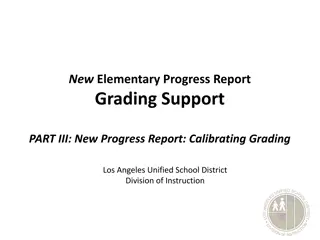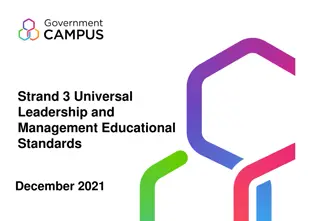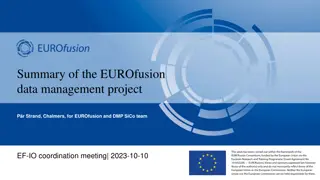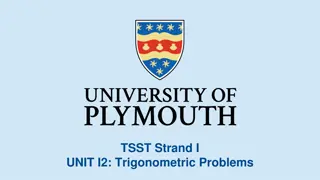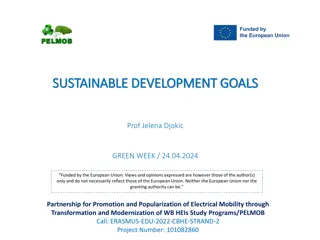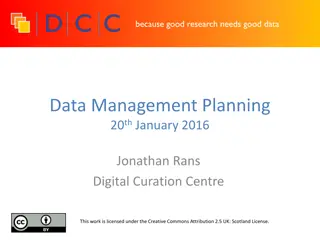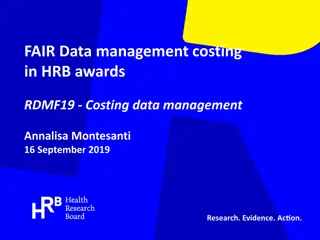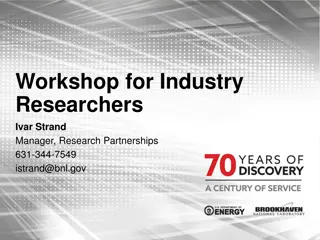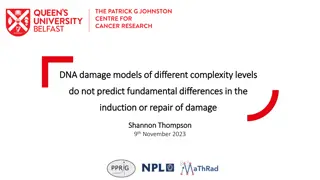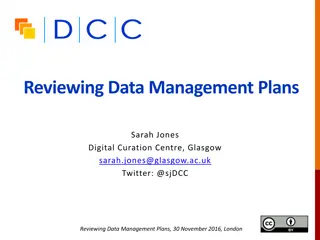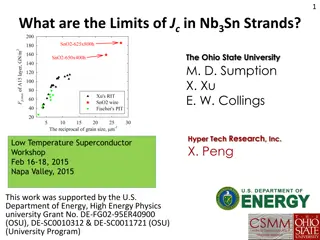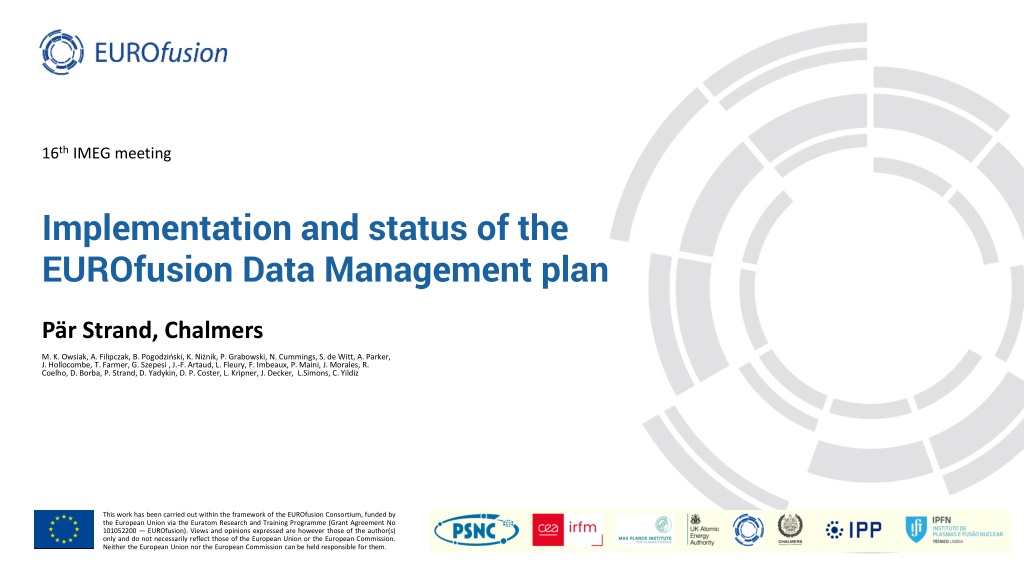
EUROfusion Data Management Plan Implementation and Status Overview
The EUROfusion Consortium is working on implementing a Data Management Plan with a focus on providing FAIR (Findable, Accessible, Interoperable, Reusable) access to experimental and modeling data. The plan involves staged approaches, starting with making metadata searchable and gradually expanding to enable data access using common tools. Core services are being developed at PSNC Gateway and participating sites to facilitate remote data access through IMAS-based tools and protocols. The plan defines scenarios/stages of increasing ambition to enhance data provenance and accessibility. The progress and challenges are being demonstrated and addressed for effective data management.
Download Presentation

Please find below an Image/Link to download the presentation.
The content on the website is provided AS IS for your information and personal use only. It may not be sold, licensed, or shared on other websites without obtaining consent from the author. Download presentation by click this link. If you encounter any issues during the download, it is possible that the publisher has removed the file from their server.
E N D
Presentation Transcript
16th IMEG meeting Implementation and status of the EUROfusion Data Management plan P r Strand, Chalmers M. K. Owsiak, A. Filipczak, B. Pogodzi ski, K. Ni nik, P. Grabowski, N. Cummings, S. de Witt, A. Parker, J. Hollocombe, T. Farmer, G. Szepesi , J.-F. Artaud, L. Fleury, F. Imbeaux, P. Maini, J. Morales, R. Coelho, D. Borba, P. Strand, D. Yadykin, D. P. Coster, L. Kripner, J. Decker, L.Simons, C. Yildiz This work has been carried out within the framework of the EUROfusion Consortium, funded by the European Union via the Euratom Research and Training Programme (Grant Agreement No 101052200 EUROfusion). Views and opinions expressed are however those of the author(s) only and do not necessarily reflect those of the European Union or the European Commission. Neither the European Union nor the European Commission can be held responsible for them.
FAIR based Implementation of the Data Managment Project FAIR - Findable, Accessible, Interoperable, Reusable Goals: Long term goal is to provide FAIR based access to EUROfusion based modelling and experimental data using IMAS as interoperable basis with addition of searchable formats. The Implementation of the EUROfusion Data management plan follows the Blueprint architecture developed by Fair4fusion project. Initially, it promotes access to searchable metadata (waveforms) and data access to a subset of data from EUROfusion discharges on the European devices through IMAS structured data. It should provide FAIR based access to EUROfusion experimental and modelling data. The activity separates into core services providing the infrastructure platform and user interfaces/authentication (PSNC) and sites (AUG, TCV, WEST, COMPASS/-U, JET, [MAST/-U]). 2 Strand | 16th IMEG meeting
EUROfusion Data management Plan staged approach The data management plan defines 4 scenarios/stages of increasing ambition. Not yet fully supported! Scenario A: making metadata only available and searchable using IMAS data subsets for interoperable Going into production on the new GW Q1 2025 (?) Prototype/demo available for testing review now! definitions of quantities [F,(I)]. Scenario B: adds to Scenario A by allowing a subset of the data to be accessed using common tools (UDA). Facilities are responsible for the access level and qualification of data through the data Prototype! Start implement! Original scope extended due to additional funding. Continued focus in 2025. User requirements and needs! mappings [F,A,I,(R)]. Scenario C: builds on the previous stages and allows for enhanced data provenance and referencing Defer. Resource restricted but important. LTDSF with PID support in the pipeline open up future possibilites through PID s [F,A,I,R]. Scenario D: adds a lightweight layer for open access to non-embargoed metadata and where allowed by the facilities also data access for export in human readable formats (CSV files) [F,A,I,R] and open. Defer. 3 Strand | 16th IMEG meeting
Status Core services at PSNC/Gateway and participating sites (AUG, COMPASS, MAST/MAST-U, TCV, WEST and JET (JDC - 2024): Demonstrated remote data access through IMAS based tools and protocols (UDA client server solution) Security layer in UDA has been delivered, migration towards JSON plugin for simplified data mappings started on several sites Population of Metadata data catalog ready for production use, awaiting new Gateway hardware. Demonstrated at SOFT 2024 ( scenario A ) Need to define a recommended list of signals from experiments based on user needs parallell session this afternoon/tomorrow! Imasification of Machine data more resources and ability to move faster on data access for users and their use cases available, but Hampered by availability of expertise funding exists but implementation slowed down by availability of diagnosticians etc. Some variation in enthusiasm from the experimental sites ? Should build a set of use cases with clear requirements Parallel session this afternoon /thursday Demonstrated ability to provide data access for user driven application needs, by running a predictive transport code (ETS) for AUG, WEST, [TCV] and ITER on DMP provided data and access tools. ( scenario B ) Expanded use requires Authentication and Authorisation technologyto be further established at all sites slow integration with EUROfusion LDAP approval/implementation of site policies delayed as knockon effect Reponsibility/willingness/ability to provide higher level data (core profiles etc) varies between sites need an harmonized approach. discussion in parallel sessions
Intermediate Summary Longer term vision: A one stop facility for researching, accessing, processing, analysing, and sharing experimental and modelling data. Technology backend (almost) ready for full deployment Still need to provide authorisation layer beyond whitelisting on sites Now time to start population data and expand data mappings (site activitites!) Recommendations on minimum data requirements Standard data for metadata waveforms Data mappings / data sets for TSVV data validation - How to manage processed data core _profiles etc at scale? Who is responsible? Reasonable progress in the 1+ year of activity Still some struggles with red tape and prioritisation at different sites Some concerns on longevity and support of some infrastructure components Next step: Develop the technology to integrate modelling data through SimDB as a site(facility) of its own. Closing the loop from data modelling - new data all available in an integrated structure. 5 Strand | 16th IMEG meeting
Approach to the Scenarios Scenario A: Metadata made available from the fusion devices Metadata is context dependent someones metadata is someone else s data and viceversa: Our definition: metadata is the waveforms needed for a researcher to not only know that a shot was performed but also to assess the shot for insights and future use . Also planned as front end for EUROfusion databases on pedestal, disruption, etc Core services delivered and supported by PSNC provides a front end dashboard providing search option and graphical interfaces Sites provide summary waveforms - (down)sampled to a single time array /discharge which are harvested by core services Provided in IDS format mainly through ids_summary , dataset_description Prototyped and ready for larger scale use Waiting for new hardware (EF/gateway) to be made available Q1 2025. Performance tuning and production release. What are the data /standard searches that users are expecting? Demonstrator Dashboard https://dmp.eufus.psnc.pl/dashboard/ 7 Strand | 16th IMEG meeting
Dashboard/Metadata server Experimental sites Findable searchable interface to multidevice data Metadata ingestions ( EUROfusion data) Notification from experiment Pull from Core Site IMAS formatted data from Experiments sites SQL database on core services Interoperable common data specification ontology - IMAS User 8 Strand | 16th IMEG meeting
Approach to the Scenarios contd Scenario B: Allow for access to higher (1d, 2d, ) dimensionality data for use with common modelling tools. Need to limit data access to data actually used, based on use cases. Use cases data needed to be available to run a particular code or a type of codes. Need to avoid open ended data mapping requests and provide a clear pathway for validating data mappings. Ex of Use cases in the EUROfusion environment: 1. Equilibrium and MHD stability 2. Predictive transport modelling (TSVV-11, TSVV-15), 3. Turbulence modelling (TSVV-1) - similar data needs as TSVV-11 (subset) 4. Energetic particle workflows (TSVV-10) as above but a further need for distribution IDS. 5. Stellarators ? IMAS compatibility? Aim of the paralellel session: initial feedback, contact points and a process for delivering the data mappings as needed for users and all TSVVs. 9 Strand | 16th IMEG meeting
Dashboard/Metadata server Experimental sites DMZ Internal Authorized data access Data Accessible through remote call (UDA) Two schools for providing data to DMZ area: Standalone IMAS data service updated on need/request Dynamic mapping with firewall passthrough Authenticated User 10 Strand | 16th IMEG meeting
Approach to the Scenarios contd Scenario B: Allow for access to higher (1d, 2d, ) dimensionality data for use with common modelling tools. The use cases have the benefit of having mature codes and expert code users involved, with codes that are or are in the process of beign fully IMASified. A lot of existing work from the EUROfusion WP CD activity can be (at least partially) reused. A drawback is that some use cases need to have processed data - core_profiles and/or core_sources etc. Typically not generated in experiments automatic pipelines. How to scale beyond data on request ? Consider moving more postprocessing to the user end (e.g., IMAS based IDA systems) Issues with data qualification and provenance trails. Different tools art different sites! Consistency issues Discussion and strategy needed paralllel sessions Data mappings effort ongoing that are now started to be tested - Data access is through remote access with UDA/AL5 tools with (in the longer term) AAI control. 11 Strand | 16th IMEG meeting
Experimental sites Dashboard/Metadata server Catalogued Simulations Persistent identifiers DMZ Internal Authorized data access Closing the loop: Reusing data providing simulations on equal footing with experiments LTDSF / SimDB Authenticated User 12 Strand | 16th IMEG meeting
Summary Implementation of the EUROfusion Data management plan is well underway Several sites: AUG, TCV, WEST, JET, MAST(-U), COMPASS(-U), different stages of dev. Scenario A: wave form metadata mostly ready. AUG (1150shot), TCV (~6000 shots) and WEST (1400 shots) ready to scale up to more complete coverage (including automatic updates of new discharges) Held back by need to move to new Gateway platform for production Q1 2025 Scenario B: > 0D data for simulations Benefits from previous work and existing routine(Trview, tcv2ids, ) and machine descriptions from WP CD Ready for first test for users and use cases Need completed AAI implementation before it can move to broader production Issues on some site to support data mapping developments Hardening infrastructure towards production Aim of parallel sessions is to provide a structured approach to support TSVV use cases Provide data sets for validation, identify TSVV contacts and specific requirements Explore pathways to massive data validation efforts a ala TSVV11 13 Strand | 16th IMEG meeting
Core services amalgation of EUROfusion and ITER software components SOFT poster: Gathering and exposing experimental meta data through a dedicated catalog System , M. Owsiak et al 15 Strand | 16th IMEG meeting
User interfaces Demonstration planned at the SOFT conference. Additional tools have been developed for the data ingestion services 16 Strand | 16th IMEG meeting
Providing WEST data WEST pulse files produced by PRC components WEST data sharing: UDA connections allowed from: ITER, Gateway and PSNC Using IP filtering, no authentication 2 IMAS databases are available: One containing diagnostics processed data One including METIS interpretive simulations carried out systematically for each pulse 17 Strand | 16th IMEG meeting


